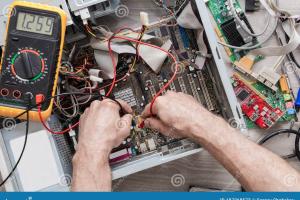Mastering Computer Diagnostics: A Comprehensive Guide to Identifying and Fixing Computer Problems

-
Quick Links:
- Introduction
- Understanding Computer Problems
- Common Symptoms of Computer Issues
- Essential Diagnostic Tools
- Step-by-Step Diagnosis Process
- Case Studies
- Expert Insights
- Preventive Measures for Future Issues
- Conclusion
- FAQs
Introduction
Diagnosing computer problems can often feel like deciphering a complex puzzle. Many users experience frustration and confusion, especially when their devices fail to perform as expected. This comprehensive guide aims to equip you with the knowledge and tools necessary to effectively identify and resolve common computer issues. Whether you're a novice or a seasoned tech enthusiast, understanding how to diagnose computer problems is an invaluable skill.
Understanding Computer Problems
Before diving into troubleshooting, it's crucial to understand the nature of computer problems. They can broadly be categorized into hardware and software issues:
- Hardware Issues: Problems related to physical components such as the motherboard, CPU, RAM, and peripherals.
- Software Issues: Problems arising from applications, operating systems, or malware.
Understanding the difference between these categories helps in diagnosing the root cause more effectively.
Common Symptoms of Computer Issues
Recognizing symptoms is the first step in diagnosing a problem. Here are some common signs that indicate a computer issue:
- Frequent crashes or freezes
- Unusual error messages
- Slow performance
- Inability to boot up
- Hardware not recognized
- Unexpected behavior from applications
Essential Diagnostic Tools
Using the right tools can simplify the troubleshooting process. Here are some essential diagnostic tools:
- Windows Event Viewer: Helps track system events and errors.
- Task Manager: Allows you to see running processes and their resource usage.
- Memory Diagnostic Tool: Tests RAM for errors.
- Disk Utility Tools: Checks and repairs disk issues.
- Anti-Virus Software: Scans for malware that may be causing issues.
Step-by-Step Diagnosis Process
Follow this structured approach to diagnose and troubleshoot computer problems:
Step 1: Gather Information
Start by collecting as much information as possible about the problem. Ask questions such as:
- When did the problem start?
- What were you doing when the issue occurred?
- Have there been any recent changes to the hardware or software?
Step 2: Basic Troubleshooting
- Restart the computer – many problems can be resolved with a simple reboot.
- Check all physical connections – ensure that cables and peripherals are securely connected.
- Run antivirus and anti-malware scans – eliminate potential threats.
Step 3: Use Diagnostic Tools
Utilize the diagnostic tools mentioned earlier to gather data about the computer's performance and health.
Step 4: Analyze System Performance
Check system resources using Task Manager to identify any processes that are consuming excessive CPU, memory, or disk.
Step 5: Check for Updates
Ensure that the operating system and all drivers are up to date, as outdated software can lead to performance issues.
Step 6: Hardware Testing
If software diagnostics do not resolve the issue, consider testing hardware components:
- Run memory tests to check for faulty RAM.
- Test the hard drive for errors using built-in tools.
- Check temperatures to prevent overheating.
Case Studies
To solidify our understanding, let’s explore some real-world examples:
Case Study 1: Slow Performance
A user reported their computer had become sluggish over time. After running diagnostics, it was found that multiple background applications were consuming resources. By disabling unnecessary startup programs, the user experienced a significant performance boost.
Case Study 2: Boot Failure
Another user faced an issue where their computer would not boot. After checking connections and using recovery tools, it was discovered that the hard drive had failed. A replacement was necessary, highlighting the importance of regular backups.
Expert Insights
To gain additional insights, we consulted IT experts:
"Always start with the simplest solutions first, such as checking connections and restarting. Complex problems often have straightforward fixes." - Jane Doe, IT Specialist
"Having a good backup strategy can save you from data loss when diagnosing hardware failures." - John Smith, Computer Technician
Preventive Measures for Future Issues
To avoid future problems, consider these preventive measures:
- Regularly update software and drivers.
- Perform routine maintenance such as disk cleanup and defragmentation.
- Use reliable antivirus software and keep it updated.
- Educate yourself on safe browsing practices to avoid malware.
Conclusion
Diagnosing computer problems can be daunting, but with the right tools and knowledge, anyone can tackle these issues effectively. By following a structured approach, utilizing diagnostic tools, and implementing preventive measures, you can maintain your computer’s performance and longevity.
FAQs
1. What are the first steps to take when my computer won’t turn on?
Check the power supply, ensure all connections are secure, and try a different outlet.
2. How can I tell if my computer has a hardware issue?
Listen for unusual noises, check for overheating, and look for error codes during startup.
3. What is the best way to diagnose a software issue?
Run antivirus scans, check for software updates, and look into recent changes made to the system.
4. How do I know if my RAM is faulty?
Use memory diagnostic tools available in your operating system to test RAM integrity.
5. What should I do if my hard drive is failing?
Back up your data immediately and consider replacing the hard drive as soon as possible.
6. Can overheating cause performance issues?
Yes, overheating can lead to throttling, crashes, and permanent hardware damage.
7. How often should I perform maintenance on my computer?
Regular maintenance should be done at least once every few months, or more frequently if you use your computer heavily.
8. Is it worth it to repair an old computer?
This depends on the cost of repairs versus the cost of a replacement. Evaluate based on your needs and budget.
9. What are signs of malware infection?
Signs include unexpected pop-ups, slow performance, and unfamiliar programs launching on startup.
10. What is the best way to prevent computer issues?
Regular updates, backups, and practicing safe browsing habits are key to preventing issues.